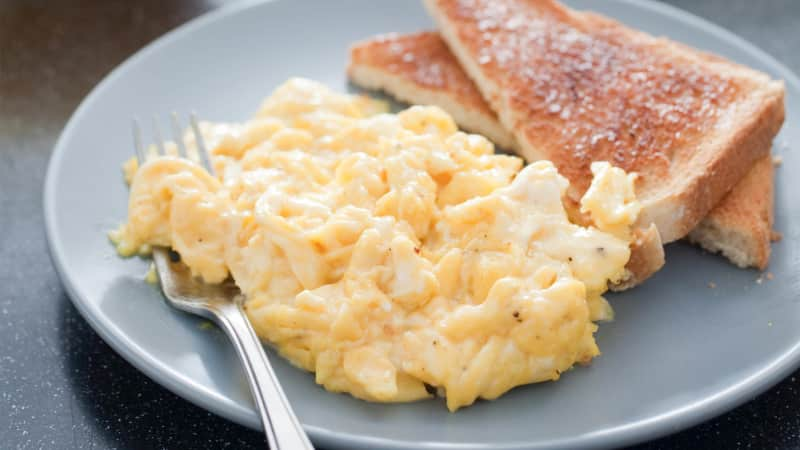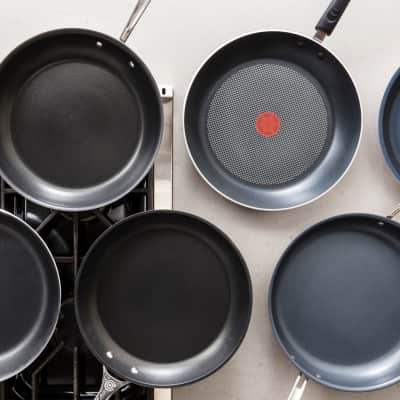I take pains with just about everything I cook, but not scrambled eggs. Usually my goal is just to get them on the table, fast. My method, such as it is, goes something like this: Whisk eggs, add a splash of milk, pour the mixture into a hot skillet, and stir over medium-high heat until the eggs puff up into large, moist curds. Trouble is, that’s not what usually happens. All it takes is the merest distraction for my eggs to go from glossy, fluffy, and wobbly to tough, dry slabs. But even when I take my time and gently stir the eggs over lower heat, I still don’t get the results I want. Instead, I end up with spoon food: curds so pebbly and fine that the mixture looks like oatmeal.
Perfect Scrambled Eggs
Published July 1, 2011.

It was time to get serious, to stop leaving everything to chance and nail down an approach to foolproof, fluffy, tender scrambled eggs.
It was time to get serious, to stop leaving everything to chance and nail down an approach to foolproof, fluffy, tender scrambled eggs.
Of Eggs and Bondage
I did a little investigation into the science of cooking eggs, and the first thing I discovered was that to produce the ideal voluptuous curds, my slapdash approach over higher heat wasn’t far off. Only relatively high heat will produce enough steam (from the dairy and the water in eggs) to puff up the scramble. As the proteins in the eggs continue to heat, they unfold and then bond together to form a latticed gel in a process known as coagulation. The texture of the eggs depends on exactly how much unfolding and bonding occurs. To create moist curds, I needed the egg proteins to bond enough to transform from a liquid into a semisolid, but not so much that they seized up into a tough mass. Fortunately, I could fall back on some lessons learned in the test kitchen over the years to address this problem.
Lesson one: Adding salt to the raw eggs makes for more-tender curds. In the same way that soaking a piece of pork in a brine solution tenderizes its protein network, salt dissolves egg proteins so that they are unable to bond as tightly when cooked.
Lesson two: Don’t overbeat the eggs or you’ll have a tough scramble. This may seem counterintuitive (since physical agitation usually destroys structure), but the principle is easily illustrated by what happens when you whip egg whites into peaks. Vigorous whisking unfolds proteins in much the same way that heat does; once unfolded, the protein strands readily bond together to form a tighter structure. Since the last thing you want to do is accelerate the unfolding process before the eggs hit the heat, beat them until just combined with the gentler action of a fork rather than a whisk.
The Dairy Godmother
I kept those points in mind as I assumed the role of short-order cook, whipping up batch after batch of scrambled eggs to see how the other major component in the mix—dairy—affected the texture. Some of the recipes I consulted called for milk, others for half-and-half or heavy cream, but all three options contain two important tenderizers: water and fat. What I needed to know was how the water-to-fat ratio in each would affect coagulation; I also needed to know exactly how dairy-rich my tasters liked their eggs.
To feed four people, I beat eight eggs with both salt and pepper and varying proportions of all three dairy options; poured the eggs into a medium-hot, butter-slicked 12-inch skillet; and dragged a heatproof rubber spatula around the pan for about two minutes, until the eggs appeared clumpy but still shiny and wet. My tasters and I mulled over the pros and cons of each dairy ingredient. Milk produced slightly fluffier, cleaner-tasting curds, but they were particularly prone to weeping. Heavy cream, on the other hand, rendered the eggs very stable but dense, and some tasters found their flavor just too rich. One-quarter cup of half-and-half fared best: Though everyone agreed that these curds could stand to be fluffier, they were decently puffed and stable thanks to the tandem effects of the liquid’s water and fat.
Sure enough, the more yolks I added to the mix, the richer the results.
Half-and-half wasn’t a perfect solution, however: Some tasters still found the dairy flavor too prominent. Less dairy would only make the recipe less foolproof, so I researched ways to boost egg flavor. The best suggestion came from a colleague. She mentioned that when her grandmother makes fresh pasta, she adds an extra yolk or two to the dough to approximate the richer flavor of farm-fresh eggs. I followed suit, and sure enough, the more yolks I added to the mix, the richer the results. There was no need to overdo it, though: Two yolks per eight eggs balanced the flavor nicely. Even better, the high proportion of fat and emulsifiers in the yolks further raised the coagulation temperature, helping to stave off overcooking.
Before I moved on to fine-tune the cooking method, I tried a couple of unconventional stir-ins that promised either fluffier or more tender eggs: vinegar and baking powder. The acidity in the former tenderized the eggs in much the same way that salt did but far more drastically: Just a drop rendered the curds mushy. A dash of baking powder was also too much of a good thing, puffing the eggs like a diner-style omelet as well as imparting a chemical aftertaste.
I also experimented with the advice of old-school French cookbooks to start with room-temperature eggs. While we’ve proved that egg temperature can influence the structure of some delicate cakes, I found that cold eggs and room-temperature eggs produced virtually identical scrambles.
So much for “secret weapons.” It was time to face the fire.
Beating the Heat
The bottom line was that no matter how perfectly I balanced the ratios of protein, fat, and water, the scrambled eggs would still fail if they overcooked. Low heat would curb overcooking, but I needed higher heat to produce nicely puffed curds. Suddenly it hit me like a whack with a cast-iron skillet: What if I used both high and low heat?
I mixed up another batch of eggs, tossed a piece of cold butter into the pan, and turned the heat to medium-high. Once the butter was melted but not brown (a cue that a pan is too hot), I added the eggs, constantly scraping the bottom and sides of the skillet to form large curds and prevent any spots from overcooking. As soon as my spatula could just leavea trail in the pan with minimal raw egg filling in the gap (about two minutes in), I dropped the heat to low and switched to a gentle folding motion to keep from breaking up the large curds. When the eggs looked cooked through but still glossy (about 45 seconds later), I slid them onto a plate to stop the cooking process. To my delight, the results were almost perfect— fluffy and tender, for sure—and the method was far more fail-safe than my high-heat-only attempts.
My tasters’ only holdover request? Larger curds, please. I tried scraping a bit less frequently, but while the curds were certainly bigger, they were also overcooked in spots. Stymied, I looked over all the elements in my recipe and realized that there was one component I hadn’t addressed: the size of the pan. In theory, my vessel choice mattered more here than in any other recipe, since a smaller skillet would keep the eggs in a thicker layer, thereby trapping more steam and producing heartier curds. Whisking together one more batch of eggs, I put aside my 12-inch skillet and grabbed a 10-inch pan instead, and then proceeded with my recipe. About three minutes later, I had the best batch of scrambled eggs yet: big billowy curds that were perfect with or without a last-minute sprinkle of fresh herbs.
I was finished with slapdash. A simple, foolproof version of my favorite breakfast was finally served.



